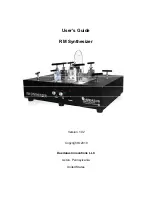
52
|
Nord Wave User Manual OS V1.00
The Mellotron company later created the M400, a smaller
instrument very similar to the one used in this presenta-
tion. This instrument was used on the road and in the
studio during the 1970’s by Led Zeppelin, Pink Floyd,
Genesis, Yes, deep Purple, Aerosmith, Wings, david Bowie,
Kraftwerk and others. during later years it has been used
by Oasis, Primal Scream, radiohead, Smashing Pumpkins,
red hot Chili Peppers, U2, Nelly Furtado, Air, rEM, Manic
Street Preachers etc. Through the extremely successful
music of these groups and artists the Mellotron sound has
been widely spread, and even though most people don’t
know that it’s a Mellotron, they’ve heard it’s sound.
History of the Mellotron sounds
The MkI instrument had two 35 key manuals, the left one
having 6 banks of rhythms and fills and the right one lead
sounds. The tapes were 3/8” 3-track just like the Chamber-
lin 600. The recordings for the Mellotron MkI were made
during 1962 and 1963 and were supervised by big band
leader Eric robinson, who also had substantial involvement
in the Mellotron company. They consisted of 18 rhythms
and fills sounds and 18 leads sounds. There were also some
more rhythms and fills recorded that were not used for the
MkI.
When the MkI was upgraded into the MkII the decision
was made to re-record many of the sounds. The only lead
sounds that were kept were the Flute, the Vibraphone and
the French Accordion. Also the 3 Violins sound from the
Chamberlin 600 was used in a slightly eq’d form, and ironi-
cally this became by far the most widely used Mellotron
sound. Among the rhythms the Afro Cuban was replaced
by the Cuban, the Slow Fox Trot and the Samba was re-
recorded, the rhythms 6/8 tempo in F and Twist in C were
added and numerous of the fills were changes.
during 1966 the decision was made to create an entirely
new single-manual instrument that was named the M300.
It had a 52 key A-C keyboard making another re-recording
of all sounds necessary. The left 17 keys mostly had
rhythms and fills and the remaining 35 lead sounds. The
machine had 2-track 1/4” tape and 6 banks.
These recordings were made during 1966 and 1967. The
only sounds that covered the whole keyboard were the
strings, the piano and the organ sound. The M300 was
produced between 1968 and 1970 and towards the end,
some of the sounds were replaced. The string sound was
changed and the Bossa Nova, the Medium Foxtrot and
the low part of the strings were replaced with Pop1 and
Pop2 rhythms and a 6/8 tempo rhythm. The leader of these
recordings was also in this case Eric robinson.
In 1970 the M400 Mellotron was created. It had a single
manual 35 key G-F keyboard, meaning that the MkI and
MkII sound libraries could be used. The machine used
3-track 3/8 tape and had interchangeable tape frames. That
meant that the sound library could be expanded according
to taste. This instrument was also the first Mellotron specifi-
cally made for professional musicians.
The new sounds for the M400 library were recorded during
the 70’s, but of course some MkII sounds were still used,
most notably the 3 Violins, the Flute and the MkII Brass. The
most well known sound introduced with the M400 was the
8 Voice Choir, even giving the Mellotron company a sales
boost.
Use of the Mellotron Sounds
Although the Mellotron had been used earlier by some
British bands, the song Strawberry Fields Forever by the
Beatles (Flute) and Nights in White Satin by the Moody
Blues (3 Violins) in 1967 became the first Mellotron ‘hits’
both in Europe, the US and the rest of the World, forever
making a mark in popular culture. The rolling Stones used
the 3 violins it in the song 10 000 Lightyears from home,
david Bowie in Space Oddity and numerous Britsh pop and
‘Progressive’ rock bands started using the Mellotron.
Among those were King Crimson (3 Violins, MkII Brass
and Cello) Yes (3 Violins, 8 Voice Choir, Vibraphone, Flute
etc) and Genesis (3 Violins, MkII Brass, 8 Voice Choir etc). It
was also widely used in German ‘Electronic’ music such as
Kraftwerk’s Trans Europe Express (3Violins) and Tangerine
dream, who used not only the standard Mellotron sounds,
but also Oboe, Bassoon, Saxophone and different string
sounds.
Led Zeppelin also used it live on Stairway to heaven, in
Kashmir and The rain Song. Even ABBA used it on Another
Town, Another Train.
during the 80’s the Mellotron remained virtually unused.
Most notable exceptions are Talk Talk in Life’s what You
Make it and OMd’s Enola Gay and other songs by these
bands.
The Mellotron experienced a renaissance during the 1990’s
when numerous bands and artists like red hot Chili Pep-
pers, Lenny Kravitz, Oasis, radiohead, Air, Monster Magnet,
rEM and Manic Street Preachers. After 2000 the Mellotron
is gaining even more popularity and has been used on hits
by dido, Nelly Furtado, daniel Powter, robyn, The Black
Eyed Peas and The Strokes to name a few.
• Mellotron is a registered trademark of Mellotron.com. All
other trademarks mentioned in this publication are the
properties of their respective holders.


































